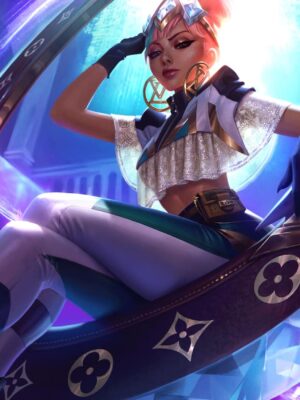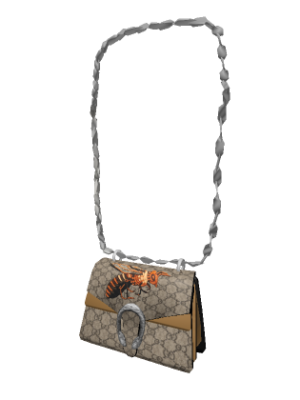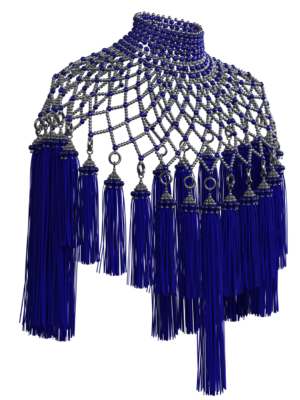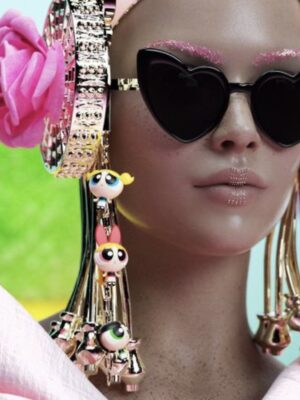With physical jewellery, consumers show it, they wear it. The joy is from the beauty and ownership, the ability to wear art with you wherever you go, to incite conversations and promote the artists you support. Currently, there are few, relatively niche online spaces for digital jewellery to be worn and ‘displayed’ on your person. A large part of the appeal for digital jewellery is the idea of having complete creative control of your appearance in metaverses, where we can be dressed and accessorised in infinite ways, with designs that reach beyond what’s possible in the physical world (owing to prohibitive cost, size or weight.)

In the past and present, jewellery is and has been largely purchased to be worn, and to become part of one’s performance of identity when viewed by others. Similarly, virtual jewellery will become a part of our online identities, and jewellery’s traditional societal ties to ideas of class and status mean that it can act as a signifier within the metaverse the same way as it does IRL. In these online spaces, consumers already spend money customising the appearance of their digital selves: in May, popular streetwear blog High Snobiety released a White Paper produced in collaboration with Civilization titled ‘Select Your Character.’ The study revealed that 60% of High Snobiety readers have purchased digital clothing/skins for their avatars. In massively multiplayer online role player games such as World of Warcraft (with 7 million monthly players) users are rewarded with more complex ‘skins’ and accessories after battles and completing tasks, identifying them as high status on the platform. In the High Snobiety ‘Select Your Character’ report, art director at Riot Games Seth Haak explains:
“We lean into a lot of gold and sparkly, because when somebody just sees something that’s bright, sparkly, and gold, then it communicates I’m really invested […] it’s a little bit of a flex.”
It may be utopian to imagine digital jewellery could disrupt these codes of class and status – after all, what would a giant diamond be worth if everyone could wear one and there was an infinite supply?

Many struggle to equate the types of consumers who play these games with consumers who are willing to seriously invest in digital accessorising, but inside games like Roblox (boasting 199 million monthly active users with an average age of 12 years old) a virtual Gucci bag recently sold for more money inside the game than its physical equivalent is worth in stores, in spite of the fact that this was not an NFT, nor would this digital asset be transferable onto any other platform. However, jewellery which would be a restrictively expensive design if created physically can exist more affordably online: DressX is currently the largest platform for purchasing digital fashion and accessories, and features designs by Object & Dawn retailing for between $35 and $145 USD which, after purchasing, is edited by DressX specialists onto images or video of you, so that on social media and online spaces, your digital self is ‘wearing’ these designs.


Digital jewellery ownership will likely serve consumers a blend of experiential and entertainment values, as we move to a more and more immersive digital world for work and play. In High Snobiety’s report, author Lucas Mascatello writes: “as our lives undergo digitization, deep fakes, designer gaming skins, and VR chat rooms seem less like one-time purchases and more like the beginnings of a posthuman marketplace.”
This is the third out of five articles on Digital Jewellery commissioned by Current Obsession and written by Jodie Marie Smith.
This series seeks to explain, suggest, hypothesise and forecast the landscape of digital jewellery in our immediate and short term futures. From today’s NFTs, blockchain gems and cryptocurrency diamond auctions, to the metaverse of VR, gaming and the social networks of internet 3.0 – jewellery has evolved beyond the physical, beyond the bounds of our reality, and beyond all definition.
Jodie Smith is a San Francisco based writer, trend forecaster and creative consultant specialising in the jewellery industry. Newly transplanted from London with a background in fine jewellery, Jodie has written for The Future Lab, Rapaport, 1st Dibs, Adorn Insight, The Adventurine, Retail Jeweller, Jewelry Connoisseur and The Jewellery Cut, amongst others. Uniquely positioned between journalists, diamond specialists, luxury brands and digital artists, she reports on every facet of the jewellery world – from the designs we covet, to consumer identities and the our digital futures.
*cover image by Aitana Basquiat digital art – to substantiate the “designs that reach beyond what’s possible in the physical world (owing to prohibitive cost, size or weight.)”





